How To Check If Nmap Is Installed On Linux
We are reader supported and may receive a committee when you make purchases using the links on our site.
The Definitive Guide to Nmap: Scanning Nuts Tutorial
Nmap (or "network mapper") is i of the about popular complimentary network discovery tools on the market. In this guide nosotros bear witness you how Nmap works and how to use information technology.
UPDATED: January 26, 2022
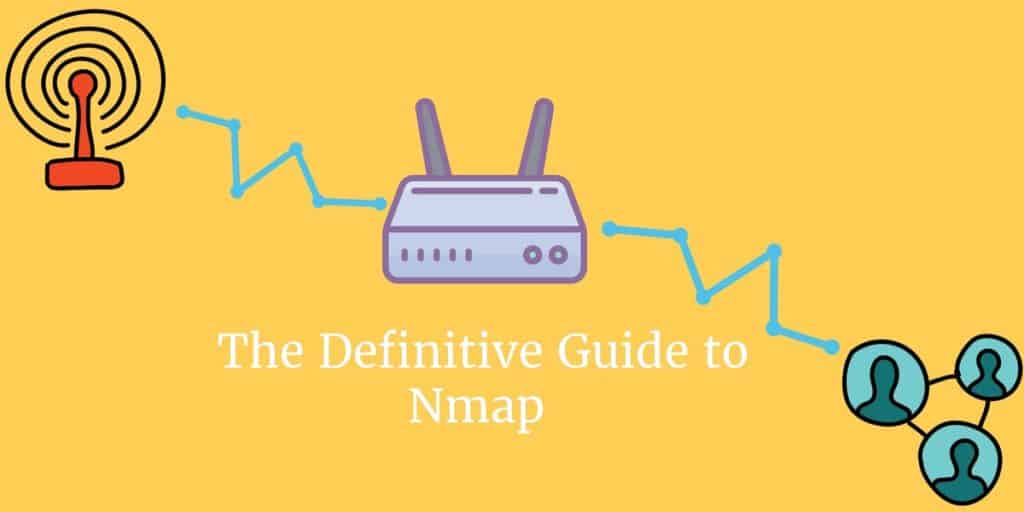
What is Nmap?
Nmap (or "network mapper") is one of the most popular gratis network discovery tools on the market. Over the past decade or so the program has emerged as a core program for network administrators looking to map out their networks and deport all-encompassing network inventories. It allows the user to find live hosts on their network systems and browse for open ports and operating systems. In this guide, you volition learn how to install and use Nmap.
Nmap runs centered around a command line similar to Windows Command Prompt, just a GUI interface is available for more experienced users. When using Nmap scanning, the user simply enters commands and runs scripts via the text-driven interface. They tin can navigate through firewalls, routers, IP filters, and other systems. At its core, Nmap was designed for enterprise-scale networks and can scan through thousands of connected devices.
Some of Nmap'due south primary uses include port scanning, ping sweeps, OS detection, and version detection. The plan works past using IP packets to place available hosts on a network as well as what services and operating systems they run. Nmap is available on many dissimilar operating systems from Linux to Free BSD and Gentoo. Nmap also has an extremely active and vibrant user support community. In this article, nosotros intermission downwards the fundamentals of Nmap to help you striking the ground running.
Network Analysis and Packet Sniffing with Nmap
Network analyzers like Nmap are essential to network security for several reasons. They can identify attackers and test for vulnerabilities inside a network. When it comes to cybersecurity, the more you know about your packet traffic, the ameliorate prepared you are for an attack. Actively scanning your network is the merely mode to ensure that y'all stay prepared for potential attacks.
Every bit a network analyzer or packet sniffer, Nmap is extremely versatile. For example, it allows the user to scan any IP agile on their network. If you spot an IP yous haven't seen before, you can run an IP scan to identify whether it is a legitimate service or an outside assail.
Nmap is the go-to network analyzer for many administrators because it offers a broad range of functions for free.
Nmap Use Cases
For example, you can utilise Nmap to:
- Identify alive hosts on your network
- Identify open ports on your network
- Identify the operating organisation of services on your network
- Address vulnerabilities in your network infrastructure
How to Install Nmap
See also: Nmap Cheat Canvas
Before we become to how to use NMap, we're going to look at how to install it. Windows, Linux and MacOS users tin download Nmap here.
Install Nmap on Windows
Apply the Windows self-installer (referred to as nmap-<version>setup.exe) and then follow the onscreen instructions.
Install Nmap on Linux
On Linux, things are a picayune trickier equally you lot tin choose between a source code install or a number of binary packages. Installing Nmap on Linux allows yous to create your ain commands and run custom scripts. To exam whether you have nmap installed for Ubuntu, run the nmap --version command. If you receive a message stating that nmap isn't currently installed, type sudo apt-become install nmap into the command prompt and click enter.
Install Nmap on Mac
On Mac, nmap offers a dedicated installer. To install on Mac, double-click the nmap-<version>.dmg file and open a file called nmap-<version>mpkg . Opening this will start the installation process. If you lot're using OS Ten 10.8 or later, y'all might be blocked past your security preferences because nmap is considered an 'unidentified programmer'. To get around this, simply right-click on the .mpkg file and select Open.
How to Run a Ping Scan
One of the basics of network administration is taking the time to identify active hosts on your network arrangement. On Nmap, this is accomplished through the use of a ping scan. A ping scan (also referred to as a notice IP's in a subnet control) allows the user to identify whether IP addresses are online. It can also exist used as a method of host discovery. ARP ping scans are one of the best means to detect hosts within LAN networks.
To run an ARP ping browse, type the following command into the command line:
# nmap -sp 192.100.1.ane/24 This will return a list of hosts that responded to your ping requests along with a total number of IP addresses at the end. An example is shown below:
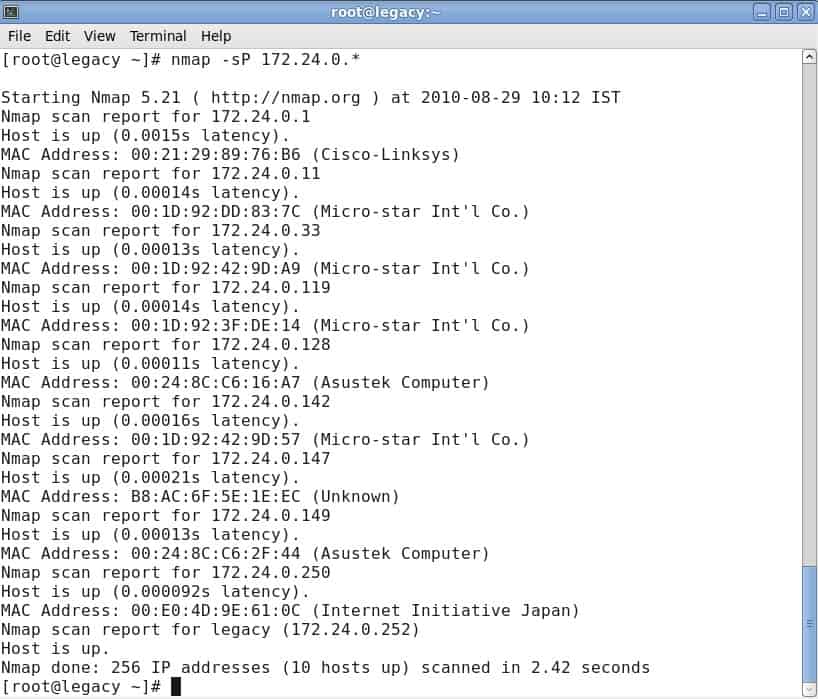
It is of import to notation that this search doesn't send whatever packets to the listed hosts. Even so, Nmap does run a reverse-DNS resolution on the listed hosts to identify their names.
Port Scanning Techniques
When it comes to port scanning, you can apply a multifariousness of unlike techniques on Nmap. These are the main ones:
-
sS TCP SYN scan -
sT TCP connect scan -
sU UDP scans -
sY SCTP INIT scan -
sN TCP Nix
Newer users will effort to solve most problems with SYN scans, but as your knowledge develops you lot'll be able to comprise some of these other techniques as well. Information technology is important to note that you tin can but apply one port scanning method at a time (although you can combine an SCTP and TCP scan together).
TCP SYN Browse
sS TCP SYN Browse The TCP SYN Scan is ane of the quickest port scanning techniques at your disposal on Nmap. Y'all can browse thousands of ports per second on whatsoever network that isn't protected by a firewall.
It is likewise a good network scanning technique in terms of privacy because it doesn't complete TCP connections that draw attention to your activeness. It works by sending a SYN packet and then waiting for a response. An acknowledgment indicates an open port whereas no response denotes a filtered port. An RST or reset identifies non-listening ports.
TCP Connect Scan
sT TCP Connect Browse A TCP Connect Scan is the primary alternative TCP scan when the user cannot run a SYN scan. Nether TCP connect scan, the user issues a connect system telephone call to constitute a connection with the network. Instead of reading through packet responses, Nmap uses this call to pull information near each connection attempt. One of the biggest disadvantages of a TCP connect browse is that it takes longer to target open ports than a SYN browse.
UDP Scan
sU UDP Browse If y'all desire to run port scanning on a UDP service, then UDP scans are your best course of activeness. UDP can be used to scan ports such equally DNS, SNMP and DHCP on your network. These are particularly important because they are an area that attackers commonly exploit. When running a UDP scan, you can also run a SYN scan simultaneously. When you run a UDP scan, y'all're sending a UDP parcel to each targeted port. In most cases, you're sending an empty packet (likewise ports like 53 and 161). If you don't receive a response later the packets are transmitted, so the port is classified as open.
SCTP INIT port browse
sY SCTP INIT Scan The SCTP INIT port scan covers SS7 and SIGTRAN services and offers a combination of both TCP and UDP protocols. Similar the Syn scan, the SCTP INIT Browse is incredibly fast, able to scan thousands of ports every 2d. It is also a good choice if y'all're looking to maintain privacy because it doesn't complete the SCTP procedure. This scan works by sending an INIT chunk and waiting for a response from the target. A response with some other INIT-ACK chunk identifies an open port, whereas an Abort chunk indicates a non-listening port. The port volition be marked as filter if no response is received after multiple retransmissions.
TCP Nada Scan
sN TCP Zippo Browse A TCP NULL browse is ane of the more crafty scanning techniques at your disposal. This works by exploiting a loophole in the TCP RFC that denotes open and closed ports. Substantially any packet that doesn't contain SYN, RST or ACK bits will prompt a response with a returned RST if the port is closed and no response if the port is open. The biggest reward of a TCP NULL scan is that you tin navigate your fashion effectually router filters and firewalls. Even though these are a good option for stealth, all the same, they can still be detected by intrusion detection systems (IDS).
Host Scanning
If you desire to identify active hosts on a network, and then the host browse is the all-time mode to do this. A host scan is used to send ARP request packets to all systems within a network. It will send an ARP request to a specific IP within an IP range and then the active host will answer with an ARP bundle sending its MAC address with a 'host is upwards' message. You will receive this message from all active hosts. To run a host scan, enter:
nmap -sP <target IP range> This will raise a screen showing the following:
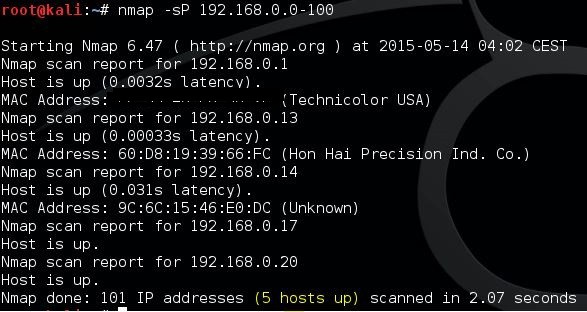
Identify Hostnames
One of the simplest and about useful commands you can use is the -sL control, which tells nmap to run a DNS query on your IP of pick. Past using this method, you can discover hostnames for an IP without sending a single packet to the host. For instance, input the following control:
nmap -sL 192.100.0.0/24 This returns a listing of names relating to the IPs scanned, which can be incredibly useful for identifying what certain IP addresses are really for (providing they have a related proper name!).
OS Scanning
Some other 1 of Nmap'south useful functions is OS detection. To observe the operating organization of a device, Nmap sends TCP and UDP packets to a port and analyzes its response. Nmap then runs various tests from TCP ISN sampling to IP ID sampling and compares it to its internal database of 2,600 operating systems. If it finds a match or fingerprint, it provides a summary consisting of the provider's name, operating system, and version.
To discover the operating system of a host, enter the following command:
nmap -O 192.168.5.102 It is important to note that yous require one open and one closed port in lodge to use the –O command.
Version Detection
Version detection is the name given to a command that allows you to find out what software version a computer is running. What sets it autonomously from most other scans is that the port isn't the focus of its search. Instead, information technology tries to detect what software a estimator runs using the information given by an open port. You lot can use version detection by typing upward the -sV command and selecting your IP of choice, for example:
#nmap -sV 192.168.one.1 Increasing Verbosity
When running any scan through Nmap, yous might crave more information. Inbound the verbose control -five will provide you with additional details on what Nmap is doing. Nine levels of verbosity are available on Nmap, from -4 to 4:
- Level -4 – Provides no output (e.one thousand. you won't see response packets)
- Level -iii – Similar to -4 simply besides provides you with mistake letters to show you if an Nmap control has failed
- Level -2 – Does the above but also has warnings and additional error messages
- Level -1 – Shows run-time information like version, outset fourth dimension, and statistics
- Level 0 – The default verbosity level that displays sent and received packets as well as other information
- Level ane – Aforementioned as level 0 but also provides detail on protocol details, flags and timing.
- Level ii – Shows more extensive information on sent and received packets
- Level 3 – Bear witness the complete raw transfer of sent and received packet
- Level 4 – Aforementioned every bit level 3 with more than information
Increasing the verbosity is not bad for finding means to optimize your scans. You increase the amount of information that yous take access to and provide yourself with more than information to make targeted improvements to your network infrastructure.
Nmap Scripting Engine
If yous want to get the most out of Nmap, then y'all're going to demand to use the Nmap Scripting Engine (NSE). The NSE allows users to write scripts in Lua then they can automate various networking tasks. A number of different script categories tin can be created with the NSE. These are:
- auth – scripts that work with or bypass authentication credentials on a target system (such as x11-access).
- broadcast – scripts typically used to observe hosts by broadcasting on the local network
- brute – scripts that use brute force to gain admission to a remote server (for example http-brute)
- default – scripts set by default on Nmap based on speed, usefulness, verbosity, reliability, intrusiveness, and privacy
- discovery – scripts that search public registries, directory services, and SNMP-enabled devices
- dos – scripts which tin can cause denial of service. Can be used to test or set on services.
- exploit – scripts designed to exploit network vulnerabilities (for example http-shellshock
- external – scripts that ship data to external databases such equally whois-ip
- fuzzer – scripts that transport randomized fields within packets
- intrusive – scripts that risk crashing the targeted system and beingness interpreted as malicious by other administrators
- malware – scripts used to examination whether a system has been infected past malware
- condom – scripts that aren't considered intrusive, designed to exploit loopholes, or crash services
- version – used under the version detection feature merely cannot be selected explicitly
- vuln – scripts designed to check for vulnerabilities and report them to the user
The NSE can exist quite complicated to get your head around at first, but after the initial learning curve, information technology becomes much easier to navigate.
For example, entering the command -sC will allow you to use the mutual scripts native to the platform. If you desire to run your ain scripts, yous tin can use the –script pick instead. It is important to remember that whatever scripts yous run could damage your system, and then double check everything earlier deciding to run scripts.
Nmap GUI Tools
Zenmap
Equally an culling to the command line interface, NMap likewise offers a GUI called Zenmap. On Zenmap you can create and execute commands and scans. The GUI is much more user-friendly than the command line interface, making it ideal for newer users. It can be used for real-time monitoring or historical data analysis. The GUI tin besides bear witness graphical comparisons of service test results, for instance:
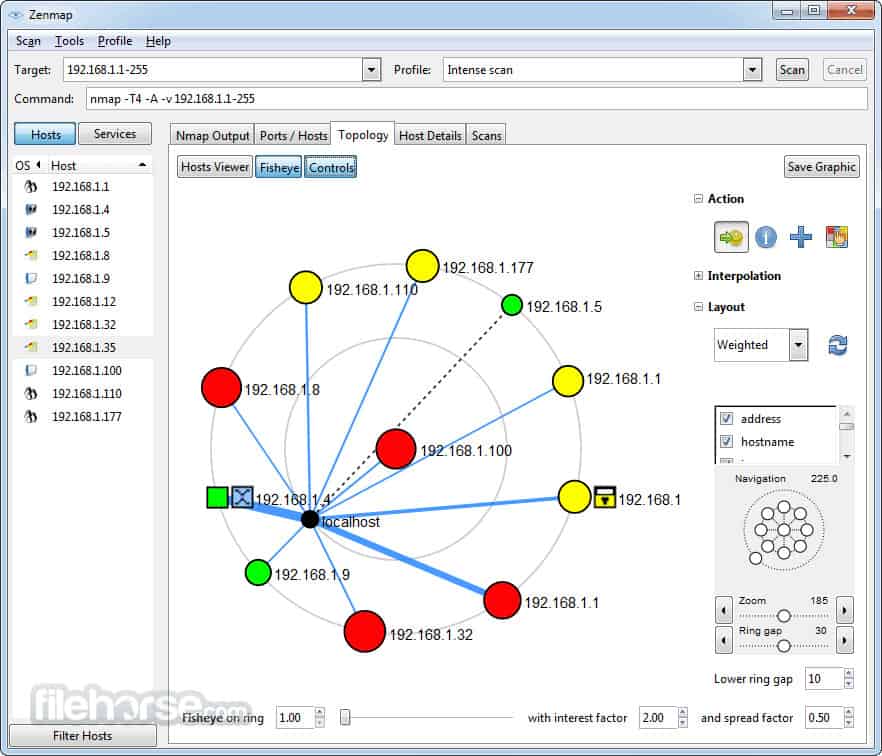
If you desire to write your own commands and scripts, and so the GUI is far from platonic and you're improve off sticking with Nmap and the control line interface.
WhatsUp Gold

WhatsUp Gilded is a existent-fourth dimension monitor with an autodiscovery office, which covers wired, wireless, and virtual environments. The software for this infrastructure monitoring tool installs on Windows Server 2008 R2, 2022, 2022 R2, and 2022. The first run of the utility will kicking off the network discovery routines. These log all of the Layer two and Layer iii devices (switches and routers) on your network and record them in a register. The discovery procedure as well generates a network map. The logging system keeps running constantly and so whatsoever changes in the network volition be reflected in the map. Deject-based services that your company uses likewise get included on the map and you lot tin can cover multiple sites to plot your WAN on one map.
The discovery process of WhatsUp Golden uses Ping and SNMP routines. The type of devices is also registered. This helps the monitor conform processes accordingly for each type of equipment. A detailed popup attached to each icon in the map will prove you lot details nearly that piece of equipment.
The statuses of the devices in the network system are monitored with SNMP. The map shows the health of each device with color: dark-green for good, yellow for warning, and red for bad. So, you tin can come across at a glance how all of those pieces of equipment are doing. Network link status is also highlighted with color: green for expert, yellow for warning, and red for congested.
Y'all tin become a Network Traffic Analysis add-on for WhatsUp Gold to become deeper intelligence on the performance of your network. This gives you greater troubleshooting capabilities through the insights on network operation both by link and end-to-stop. A capacity planning scanning tool helps you lot predict demand and expand resource where necessary.
Paessler PRTG Network Monitor
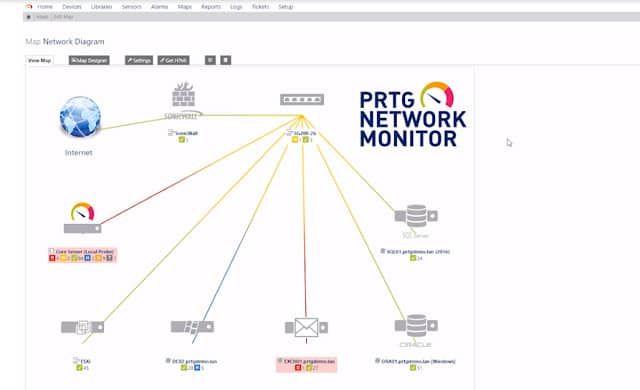
Paessler PRTG Network Monitor uses the Simple Network Management Protocol (SNMP) to locate all of the devices on your network and provide real-fourth dimension monitoring capabilities. One time each slice of equipment has been discovered, it is logged in an inventory. The inventory forms the basis of the PRTG Network Map. Y'all can reorganize the map manually if yous like and you tin also specify customized layouts. The maps aren't limited to displaying the devices on ane site. It tin evidence all of the devices on a WAN and even plot all of the company's sites on a real map of the globe. Cloud services are too included in the network map.
The network discovery function of PRTG runs continually. So, if y'all add, move, or remove a device, that change volition automatically be shown in the network map and the equipment inventory will likewise be updated.
Each device on the map is labeled with its IP address. Alternatively, you can choose to take devices identified by their MAC addresses or their hostnames. Each device icon in the map is a link through to a detail window, which gives data on that piece of equipment. You can change the display of the network map to limit it to devices of a particular type, or just show one section of the network.
Paessler PRTG is a unified infrastructure monitoring system. It volition also keep track of your servers and the applications running on them. There are special modules for monitoring websites and the monitor is able to cover virtualizations and wifi networks likewise.
Paessler PRTG is bachelor as an online service with a local collector agent installed on your organization. Alternatively, you can choose to install the software on the bounds. The PRTG system runs on Windows computers, but it can communicate with devices running other operating systems. PRTG is available for download on a free trial.
Alternatives to Nmap
Although regular users of Nmap swear by it, the tool does have its limitations. Newcomers to network administration accept learned to look a GUI interface from their favorite tools and improve graphical representations of network functioning issues. The en-map adaptation of Nmap (meet below) goes a long way towards addressing these needs.
If you don't want to utilise a control line utility, in that location are alternatives to Nmap that you could check out. SolarWinds, which is one of the world's leading producers of network administration tools, even offers a port scanner. The analytical functions of Nmap are not so neat and you may find yourself researching other tools to further explore your network'southward statuses and performance.
Nmap: An Essential Network Administration Tool
Ultimately, if yous're looking for a tool that allows you to target systems inside your network and navigate effectually firewalls, then Nmap is the tool for you lot. Though it is not as glamorous as some of the other network analysis tools on the market, it remains a core part of near IT administrators' toolkits. Ping scans and port scans are simply the tip of the iceberg when talking about what this platform is capable of.
If yous'd like to acquire more nearly Nmap, an extensive community website is full of guides and data to help you become the most out of your experience. You lot tin access the Nmap documentation over at the tool's site. One time you get by the learning curve, you'll non just accept more transparency over your network, only you will exist able to safeguard your systems against future threats. Just showtime out by learning the basics and you'll do just fine with NMap.
How to use Nmap FAQs
Is scanning with Nmap illegal?
It isn't illegal to scan ports on your own system. It isn't fifty-fifty illegal to scan ports on someone else'southward public-facing infrastructure. It is illegal to break into a system past using the information y'all gain from using Nmap.
What is the Nmap aggressive fashion?
Aggressive mode is activated by the -A option on the command. This activates a package of options: OS detection (-O), version detection (-vS), script scanning (-sC), and traceroute (-traceroute). If you want to use those four functions, it'due south a lot quicker to just type -A.
How long do Nmap scans take?
Nmap takes about 21 minutes for each host continued to the network.
Source: https://www.comparitech.com/net-admin/the-definitive-guide-to-nmap/
Posted by: herringcomentend.blogspot.com


0 Response to "How To Check If Nmap Is Installed On Linux"
Post a Comment